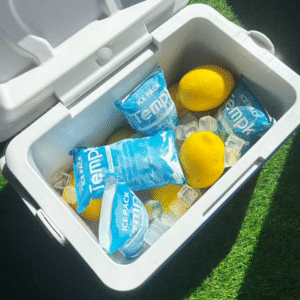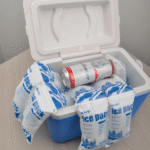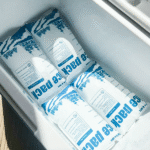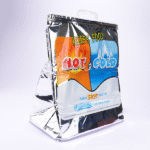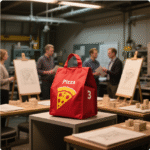The term last mile cold chain refers to the final, often most challenging step in transporting temperature sensitive products. It’s where the product leaves the distribution hub and reaches you. In 2025 the global cold chain logistics equipment market is projected to climb from USD 94.3 billion in 2025 to USD 179.8 billion by 2034, and this surge is fuelled by the booming demand for pharmaceuticals, vaccines, fresh food and online grocery deliveries. However, more than $35 billion is lost each year due to failures in temperature control within the biopharma industry. Ensuring that perishables stay within their required temperature range during the last mile isn’t just about quality—it’s about protecting health, reducing waste and meeting customer expectations. This guide explores why the last mile matters, the challenges you face, the technologies redefining cold chain logistics, and the trends shaping 2025.
What makes last mile cold chain critical for pharmaceuticals and food? – Understand why direct contact with consumers and complex handoffs raise the stakes for cold chain deliveries.
What are the major last mile challenges and how can you solve them? – Learn about compliance, distribution complexity and agile route planning, and discover strategies such as IoT enabled monitoring.
Which technologies are transforming last mile cold chain logistics in 2025? – Explore the impact of AI, real time sensors, autonomous vehicles and dynamic routing.
How regulations and sustainability shape the last mile cold chain – See how regulators set requirements for temperature, packaging and monitoring, and how greener practices reduce emissions and costs.
What are the latest trends and market insights for 2025? – Gain perspective on market growth, digital logistics, e grocery, cross docking and the shift to electric vehicles.
Why is last mile cold chain critical?
Ensuring efficacy when products reach the end user. The last mile is the final leg of a supply chain, delivering goods from a transportation hub to their ultimate destination. In a cold chain, this stage involves products such as vaccines, biologics and fresh foods that must stay within a precise temperature range to maintain quality. Unlike earlier segments of the supply chain—where power supplies and large refrigeration units make temperature control easier—the last mile often lacks continuous power, involves multiple handoffs and can face congestion or weather delays. Small variations in temperature during this stage can destroy potency, wasting valuable medicines and causing health risks.
Understanding last mile cold chain for pharmaceuticals and food
Many pharmaceuticals and biologics require strict temperature ranges to remain effective. A cold chain failure at the last mile can render vaccines useless or spoil fresh produce. The global biopharmaceutical industry loses more than $35 billion annually due to inadequate temperature control. Proper last mile delivery therefore safeguards both patient safety and brand reputation. For food and beverage sectors, the last mile determines shelf life, taste and compliance with regulations. Because this leg involves direct contact with consumers, any failure is highly visible.
| Key Elements of Last Mile Cold Chain | Description | What it means for you |
| Temperature controlled storage | Specialized refrigerated hubs keep goods within a set temperature before dispatch. | Ensures products start the last mile at the correct temperature, reducing risks of spoilage. |
| Temperature controlled transport | Customized packaging and insulation (phase change materials, dry ice, gel packs) maintain temperatures during transit. | Allows you to ship medicines, vaccines and perishable foods safely even during delays. |
| Trained personnel | Staff must understand handling procedures, monitor temperatures and manage unexpected issues. | Reduces human error, ensures compliance and protects product integrity. |
Practical tips for keeping products safe
Pre condition your packaging: Ensure gel packs or phase change materials are at the desired temperature before loading to avoid thermal shock.
Limit handoffs: Each transfer increases the risk of temperature excursions; plan routes that minimise stops.
Use insulated containers: Choose boxes with adequate insulation thickness and consider vacuum insulated panels for long distances.
Case example: A pharmaceutical company shipping temperature sensitive biologics reduced spoilage by 40% by investing in vacuum insulated boxes and training drivers to handle re icing procedures.
What challenges face last mile cold chain logistics?
Maintaining compliance and quality under pressure. Last mile distribution is often the most complex and costly part of the cold chain. Regulations from agencies such as the FDA, TSA and IATA specify detailed requirements for temperature, packaging, monitoring and documentation. Meanwhile, the last mile must balance diverse distribution needs—serving hospitals, clinics, grocery stores and consumers—while planning routes that are both efficient and flexible. Small delays can lead to temperature excursions, spoilage or lost credibility.
Compliance, distribution and route planning
Cold chain goods must remain within strict temperature ranges, and minor fluctuations can lead to spoilage. Wholesalers must provide detailed documentation at every stage to satisfy regulators. Uncertainties—traffic, weather or sudden delivery changes—complicate scheduling. Distribution networks often span both business to business (B2B) and business to consumer (B2C) channels, each with unique handling requirements. To keep up with rising consumer expectations for same day or next day delivery, routes must be dynamic rather than fixed.
| Challenge | Typical issue | Solution | What it means for you |
| Compliance management | Numerous regulations demand meticulous temperature monitoring and record keeping. | IoT enabled sensors and GPS tracking provide real time visibility and trigger alerts. | Enables proactive corrective action and simplifies audits. |
| Balancing diverse distribution | Serving varied locations (hospitals, clinics, grocery stores) with different requirements can cause delays or errors. | Automated sorting and labeling technology reduces handoff mistakes and speeds up transfers. | Improves accuracy and efficiency across channels. |
| Agile route planning | Fixed routes lack flexibility to meet urgent demands. | Dynamic transportation management systems (TMS) adjust routes based on real time conditions such as traffic and weather. | Balances cost and speed, meeting customer expectations for faster delivery. |
Strategies to overcome challenges
Adopt real time monitoring: Equip vehicles with IoT sensors and GPS to track temperature, humidity and location continuously. Automated alerts allow immediate corrective action.
Automate sorting and labeling: Use barcodes and RFID to distinguish between shipments for clinics, hospitals and home delivery; this reduces handoff errors.
Implement dynamic route planning: Leverage TMS platforms that integrate traffic data, weather and delivery windows. Dynamic routing reduces delays and improves on time delivery.
Case example: A regional grocery chain serving online orders and local stores used a dynamic TMS to adapt routes in real time, reducing delivery times by 18% during peak seasons.
How are new technologies improving last mile cold chain delivery?
Technology is making the last mile smarter, faster and more transparent. Advanced IoT devices, artificial intelligence (AI) and automation are transforming the cold chain. Sensors now monitor temperature, humidity and location in real time, and data is stored for compliance and predictive analytics. AI optimizes routes, forecasts demand and predicts equipment failures. Automation—robots, drones and autonomous vehicles—promises to reduce labour costs and speed deliveries.
Smart sensors and real time monitoring
IoT enabled sensors collect continuous data on temperature, humidity and location throughout the last mile. This visibility prevents spoilage and ensures regulatory compliance. When paired with cloud based platforms, the data can be analyzed for trends, enabling predictive maintenance and more accurate planning.
AI driven logistics and automation
AI and machine learning algorithms optimize delivery routes, forecast demand and reduce fuel consumption. Predictive analytics helps companies anticipate traffic patterns and avoid delays. Robotics and autonomous vehicles are moving from pilot projects to wider adoption. Drones, self driving vans and robotic couriers promise to cut delivery times and labour costs but still face regulatory and infrastructure hurdles.
Enhanced customer experience
Customers expect real time visibility and flexible options. Logistics providers now offer dynamic routing and rescheduling, eco friendly delivery choices and AI powered customer service chatbots. Consumers can choose electric vehicle delivery or consolidated shipments, change delivery windows on the fly and receive proactive notifications.
| Technology | Benefit | What it means for you |
| IoT sensors & data loggers | Provide continuous monitoring of temperature, humidity and location. | Prevent spoilage, ensure compliance and enable predictive maintenance. |
| AI powered route optimization | Uses real time data to select the most efficient route. | Reduces delivery times and fuel costs, meeting customer expectations for fast delivery. |
| Autonomous vehicles & drones | Test projects show potential for faster, lower cost deliveries. | Promise to reduce labour costs and enable same day or intra hour deliveries. |
| Dynamic TMS and cloud platforms | Integrate traffic, weather and demand data to adjust routes on the fly. | Balances efficiency and flexibility for high volume delivery operations. |
Implementation tips
Start with pilot projects: Deploy sensors on a small number of routes to validate data quality and refine your processes.
Integrate systems: Connect your TMS with IoT sensors and CRM so that routing decisions and customer notifications share the same data.
Train staff on tech: Drivers and dispatchers should know how to use the technology and respond to alerts.
Case example: A national pharmacy chain deployed IoT enabled sensors across its delivery fleet and integrated them with an AI powered routing system. After six months, the chain reduced temperature excursions by 70% and cut fuel costs by 12%.
Regulatory and sustainability considerations in the last mile cold chain
Balancing compliance and environmental responsibility. Cold chain logistics is subject to strict regulations. In the US, agencies such as the FDA, IATA, TSA and DOT specify requirements for temperature, packaging, stability and monitoring. Compliance extends to training personnel, documenting conditions and ensuring that products remain within their specified range until delivered.
Green logistics and compliance
Growing consumer awareness and stricter regulations are pushing companies to adopt sustainable practices. The cold chain equipment industry is moving toward electric and hybrid refrigeration units, natural refrigerants and energy efficient compressors. Logistics providers are expanding electric delivery fleets, using bicycles and micro mobility solutions in dense urban areas, reducing packaging waste and investing in renewable energy. Regulatory bodies require validation of temperature control, proper packaging and documentation, while sustainability initiatives often go hand in hand with cost reduction.
| Consideration | Regulatory guideline / Sustainability practice | Practical significance |
| Temperature standards | Cold chain products fall into ranges: deep freeze (–28 °C to –30 °C), frozen (–16 °C to –20 °C), chill (2 °C to 4 °C), pharma (2 °C to 8 °C) and cool chain (12 °C to 14 °C). | Selecting appropriate packaging and monitoring ensures compliance and product integrity. |
| Regulatory agencies | FDA, IATA, TSA, DOT and others set requirements for temperature, transport, stability, packaging and monitoring. | Staying compliant avoids fines, recalls and reputational damage. |
| Green logistics | Use electric vehicles, sustainable refrigerants and energy efficient equipment; reduce packaging waste. | Decreases emissions, lowers operational costs and appeals to eco conscious consumers. |
| Documentation & traceability | Maintain end to end data logs for temperature and location. | Facilitates audits and builds trust with regulators and customers. |
Practical advice for sustainability and compliance
Opt for electric or hybrid refrigeration units: They reduce fuel use and emissions while meeting regulatory requirements.
Use natural refrigerants: CO₂ and other natural refrigerants help meet environmental regulations and reduce greenhouse gas impact.
Implement a traceability system: Automated data loggers and blockchain technology ensure end to end visibility and simplify audits.
Case example: A meal kit delivery service switched to electric vans and reusable insulated packaging. The company cut its carbon footprint by 25%, saved on fuel costs and attracted environmentally conscious customers.
2025 last mile cold chain developments and trends
Trend overview
In 2025, cold chain logistics is evolving rapidly. Demand for temperature sensitive products—from biologics to organic food—continues to rise. The cold chain logistics equipment market is forecast to grow from USD 94.3 billion in 2025 to USD 179.8 billion by 2034, with a 7.4% CAGR. The global digital logistics market is expected to reach $46.5 billion by the end of 2025, growing at a CAGR of 21%. E commerce and online grocery shopping are driving demand for efficient last mile cold storage and transport, while sustainability initiatives and stricter regulations are accelerating adoption of green solutions.
Latest developments at a glance
IoT enabled smart logistics: Sensors and cloud platforms provide real time temperature monitoring and predictive analytics. This visibility prevents spoilage and supports proactive maintenance.
AI and predictive analytics: AI optimizes routes, manages inventory and forecasts demand. Predictive analytics reduces stockouts, anticipates traffic and improves efficiency.
Autonomous delivery and drones: Companies are testing drones and autonomous vehicles for last mile delivery. While full deployment faces regulatory hurdles, early pilots show potential to cut costs and improve speed.
Cross docking and micro fulfillment: As warehouse space becomes scarce, cross dock facilities and urban micro fulfillment centers shorten the distance between inventory and customers. These facilities enable rapid transfer without long term storage and reduce dwell time for perishables.
Sustainable fleets and packaging: Logistics providers are expanding electric delivery fleets and using bicycles or micro mobility options in dense cities. Biodegradable or reusable packaging reduces waste and meets consumer expectations for sustainability.
Market insights
The cold chain equipment market growth is driven by rising demand for temperature sensitive products, e grocery and sustainable logistics. Digital logistics growth reflects increased investment in IoT, AI and cloud platforms. However, challenges remain: high operational costs, lack of infrastructure in some regions and regulatory complexity. Companies leading the market focus on adopting advanced technologies, modular storage solutions and green refrigerants. For small and medium enterprises, partnering with third party logistics providers and adopting scalable TMS platforms can mitigate costs and complexity.
Frequently Asked Questions
- Why is temperature control so important in last mile cold chain logistics?Temperature sensitive goods like vaccines and fresh foods can lose potency or spoil if temperatures vary during the last mile. The biopharma industry alone loses more than $35 billionannually due to temperature control failures. Real time monitoring and proper insulation help maintain quality.
- How does last mile cold chain differ from general cold chain logistics?While the entire cold chain relies on temperature control, the last mileinvolves delivery from a hub to the end user. This stage often lacks continuous power and has multiple handoffs, making temperature control more challenging than earlier segments.
- What role does AI play in last mile cold chain delivery?AI uses real time data to optimize routes, forecast demand and predict equipment failures. When combined with IoT sensors, AI helps prevent spoilage, reduce fuel consumption and improve customer satisfaction.
- How can small businesses implement last mile cold chain solutions?Start small by equipping vehicles with IoT data loggers, partner with third party logistics providers for compliance and invest in dynamic routing software. Pilot programs help test technologies before broader adoption.
- Are electric delivery vehicles practical for cold chain logistics?Yes. Electric and hybrid refrigeration units reduce fuel costs and emissions while meeting temperature requirements. Many logistics providers are expanding electric fleets and using micro mobility solutions for urban deliveries.
Summary and recommendations
The last mile is the most critical and complex stage of the cold chain. It directly affects product quality, patient safety and customer satisfaction. The cold chain logistics equipment market is growing rapidly, driven by demand for pharmaceuticals, biologics and fresh foods. At the same time, more than $35 billion is lost each year due to temperature control failures. To succeed in 2025 and beyond, businesses must invest in real time monitoring, AI driven route optimization, dynamic TMS platforms, and sustainable practices. Regulatory compliance and sustainability are not optional; they are essential to meeting customer expectations and reducing costs. Embrace IoT sensors, electric vehicles and cross docking to build a resilient, responsive last mile cold chain.
Actionable next steps
Evaluate current last mile processes: Map your distribution networks, identify pain points and calculate current spoilage or waste rates.
Deploy IoT sensors and data loggers: Start with a pilot route to gain visibility into temperature and location data. Use these insights to improve packaging and handling.
Implement dynamic routing: Invest in TMS software that integrates real time data (traffic, weather, customer windows) to optimise routes and reduce delays.
Adopt sustainable practices: Transition to electric or hybrid refrigeration units, reduce packaging waste and use natural refrigerants. These steps lower costs and improve your brand’s environmental footprint.
Partner with experts: Collaborate with third party logistics providers who specialise in cold chain solutions and regulatory compliance.
About Tempk
Tempk (Shanghai Huizhou Industrial Co., Ltd.) was established in 2011 with a registered capital of 30 million. Headquartered in Shanghai with seven or more factories across China, Tempk is a high tech enterprise focused on research, development, production, sales and service of cold chain products. The company provides phase change cold storage materials, pharmaceutical refrigeration and incubators, fresh food insulation products and temperature control verification services for major pharmaceutical groups and fresh food e commerce companies. Its product range includes gel ice packs, dry ice packs, freezer bricks, insulated bags, EPP insulated boxes and other cold chain packaging solutions. With extensive R&D and state of the art manufacturing, Tempk delivers reliable, efficient and eco friendly cold chain solutions for global customers.
Call to action: Reach out to Tempk’s experts to discuss how our cold chain packaging solutions and real time temperature control technologies can safeguard your products and streamline your last mile deliveries. Contact us today for a customised consultation.






